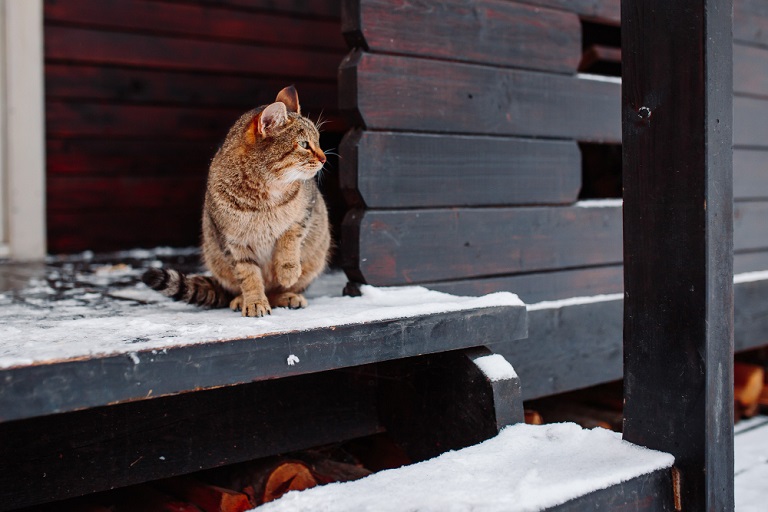How To Make Wooden Stairs Less Slippery This Winter?

Whether it’s sitting outside in the sun to soak up the rays or standing around covered up with a hot beverage to take in the beauty of the snow, everyone enjoys spending time relaxing on the deck at any time of year. However, as we enter the Autumn season, it’s crucial to remember to keep deck steps non-slippery for family and friends.
Creating Non-Slip Stairs
There are various methods available to make your stairs anti-slip. For non-slip indoor stair treads, non-slip stair treads can be added. These treads are designed with textured surfaces that significantly increase traction, making the stairs safer to use. Similarly, for wooden stairs, non-slip wood stair treads can be utilized, which have the additional benefit of preserving the aesthetic appeal of the wood while increasing safety.
Deck stairs can also be made non-slip by using deck stair non-slip treads or non-skid stair strips. These are especially helpful for outdoor wooden stairs, which can become extremely slippery when wet.
It’s critical for all homeowners to bear in mind that everyone, from your spouse and children to your furry family pet, is safe when walking on snow and ice, especially on slippery wooden stairs.
- Prevent The Formation Of Ice
While it may seem obvious and time-consuming, the best approach to prevent ice from forming on wooden steps is to clear snow as soon as it falls. While this isn’t a permanent solution, plan to shovel or sweep the deck stairs frequently or until they come if you’re expecting visitors. In addition, it will ensure that the stairwell remains open and accessible to all. But do you have enough time and energy to do this tiring task many times a day?
- Agent Of Traction
When it’s freezing outside, wooden steps can become a tripping hazard. Clear snow from your steps as soon as possible after it falls to avoid slipping. Use a natural and quick traction agent to improve traction on wooden steps. You can use a mineral-based traction agent; it is safe for people, pets, and surfaces. Walking on snow and ice becomes a non-slip winter activity with this easy-to-carry and use traction agent.
- Install Tread Strips
Rubber or other synthetic tread strips are an excellent solution to keep your wooden steps free of ice. To prevent the strips from dislodging during use, tack them to your wooden steps.
Like all ice-control techniques, tread strips function best when you stay proactive. Remove snow off steps as soon as possible after a snowstorm. When snow is allowed to settle and compact, slick conditions can develop, so shovel or sweep your steps as quickly as possible after a snowstorm. Even after using tread strips, you need to be ready with your shovel.
- Use A Towel
One essential household item, a towel, can make iced-over wooden steps safe. Just place a towel on top of slick steps.
It’s better to clean the snow and ice off the steps before using this procedure. Using a towel as an impromptu tread strip in icy situations keeps both humans and animals safe. But it is not a foolproof anti-slip solution.
- Using An Ice Melt
You can use a de-icer to break up stubborn ice and snow. Make sure, however, that the one you choose will not ruin your steps or deck. Rock salt and other common salts are slow. These ice melts not only hurt the wood, neighboring plants, your pets’ paws, and your patio but also aren’t very effective. Calcium chloride ice melt works at low temperatures, but it’s a corrosive product that’ll ruin your wooden steps.
Get ready for winter with Walk On Ice instant traction on snow and ice
The Magic Solution: Walk On Ice
While the above methods can help, they might not be sufficient when it comes to icy conditions. Traditional solutions like sand and kitty litter are often used, but they aren’t particularly effective and can cause a mess. A superior alternative is the product ‘Walk On Ice.’
Walk On Ice can be used to create an instant skid-free, slip-free surface on ice and snow. It’s not just limited to stairs; Walk On Ice can also be used on sidewalks, driveways, and even under your car tires for instant traction. Made from 100% naturally occurring minerals, Walk On Ice is safe for all surfaces, pets, and humans.
What To Put On Outside Steps To Prevent Slipping In Winter
Once you’ve cleared the snow, the next question is: what should you actually put on outside steps to prevent slipping in winter? Homeowners often reach for whatever’s on hand—salt, sand, kitty litter—but each comes with its own set of trade-offs.
For example, sand for ice traction can create a gritty surface that helps boots grip the stairs, but it scatters easily and needs constant reapplication. On windy days or after heavy foot traffic, you may find yourself sprinkling sand several times just to keep the steps safe.
As for kitty litter, even the best kitty litter for snow traction has the same problem—once it absorbs water, it turns clumpy and messy, leaving you with an even bigger cleanup task when the ice finally melts. It can also stick to shoes and get tracked into the house, which no one appreciates.
That’s why more homeowners are turning to non-corrosive traction agents that don’t just add grit but actively create a stable walking surface without damaging wooden stairs or leaving behind a mess.
How To Make Stairs Less Slippery For Dogs (And Everyone Else)
It’s not just people who struggle on icy steps—our pets do, too. Dogs, especially older ones, often have a hard time keeping their footing when stairs are glazed over with ice. Paw injuries from slipping are more common than you’d think, and salt-based products can irritate sensitive paws.
So, how to make stairs less slippery for dogs? The best approach is to use pet-safe traction methods. Installing outdoor stair treads designed for winter is a solid long-term fix—they give extra grip without relying on chemicals. Pairing those with a natural traction agent like Walk On Ice can make every trip outside safer for pets and humans alike. Unlike salt or chloride-based products, Walk On Ice won’t sting paws or harm their health if they accidentally lick their feet after being outside.
For households with active pets, this can be a game-changer—no more struggling at the door or carrying your dog down the steps when the stairs are too slick.
Why Traditional Fixes Don’t Always Work
We’ve all heard about using sand, kitty litter, or even old rugs on steps in the winter. While these may work in a pinch, they don’t provide consistent safety. Rugs can freeze to the stairs and become stiff, while kitty litter makes for a messy cleanup job in spring. Even with sand for ice traction, the benefits are short-lived, and you’re left sweeping up piles of sand once the snow melts.
The real issue is that these methods don’t address the thin film of water on top of the ice that causes the slipperiness in the first place. That’s why purpose-designed traction agents are different—they absorb that water layer and create a rough, sandpaper-like grip immediately.
Walk On Ice: Extending Safety Beyond Just Stairs
The beauty of Walk On Ice is its versatility. While most people think of it for driveways and sidewalks, it’s just as effective on wooden stairs. Unlike salts that corrode surfaces, Walk On Ice is safe for wood, decking, pavers, and even delicate landscaping around your stairs.
Another bonus? It’s portable. A canister fits right into a coat pocket or bag, so you can sprinkle it on outdoor stairs when you need it most—whether you’re hosting guests, letting the dog out, or simply grabbing the mail. This flexibility makes it stand out compared to traditional methods like sand or kitty litter.
Plus, because it’s mineral-based and natural, you don’t have to worry about environmental damage or indoor mess when it’s tracked inside.
Conclusion: Smarter Ways To Keep Stairs Safe
So, when it comes to deciding what to put on outside steps to prevent slipping in winter, think beyond the quick fixes. While sand for ice traction and the best kitty litter for snow traction might seem handy, they come with messy downsides and short-lived effectiveness. For households with pets, especially, focusing on how to make stairs less slippery for dogs is just as important as keeping people safe.
Outdoor stair treads, careful snow removal, and pet-friendly traction agents like Walk On Ice all combine to create a safer environment. Walk On Ice, in particular, works instantly, doesn’t harm your wooden stairs, and keeps both two-legged and four-legged family members steady in winter.
At the end of the day, preventing slips is about more than convenience—it’s about peace of mind. When you know your stairs are safe, you can actually enjoy winter mornings on the deck or let the kids and pets outside without worry. And that’s what winter safety should be: practical, reliable, and stress-free.
FAQs
Other Ice Melt Products
Safe Paw
The Original and #1 Selling Pet and Child Safe Ice Melt for over 20 years. Guaranteed environmentally safe – will not harm waterways and sensitive wetlands. All products are made in the USA.

Safe Thaw
Imagine an ice melt you can put down and never worry about. It won’t harm pets, kids, and your property. That’s Safe Thaw. Unlike anything else on the market, Safe Thaw can change how winter affects our planet.



